这期内容当中小编将会给大家带来有关如何上线部署Pytorch深度学习模型到生产环境中,文章内容丰富且以专业的角度为大家分析和叙述,阅读完这篇文章希望大家可以有所收获。
Pytorch和TensorFlow是目前使用最广泛的两种深度学习框架,在上一篇文章《自动部署深度神经网络模型TensorFlow(Keras)到生产环境中》中我们介绍了如何通过AutoDeployAI的AI模型部署和管理系统DaaS(Deployment-as-a-Service)来自动部署TensorFlow模型,本篇我们将介绍如果通过DaaS来自动部署Pytorch深度神经网络模型,同样我们需要:
安装Python DaaS-Client
初始化DaasClient
创建项目
完整的代码,请参考Github上的Notebook:deploy-pytorch.ipynb
DaaS是基于Kubernetes的AI模型自动部署系统,模型运行在Docker Container中,在DaaS中被称为运行时(Runtime),有两类不同的运行时,分别为网络服务运行环境(Environment)和任务运行环境(Worker)。Environment用于创建网络服务(Web Service),而Worker用于执行任务(Job)的部署,比如模型评估和批量预测等。DaaS默认自带了四套运行时,分别针对Environment和Worker基于不同语言Python2.7和Python3.7,自带了大部分常用的机器学习和深度学习类库,但是因为Docker镜像(Image)大小的缘故,暂时没有包含Pytorch库。
DaaS提供了自定义运行时功能,允许用户把自定义Docker镜像注册为Runtime,满足用户使用不同模型类型,模型版本的定制需求。下面,我们以部署Pytorch模型为例,详细介绍如何创建自定义运行时:
一般来说,有两种方式创建Image,一种是通过Dockerfile构建(docker build),一种是通过Container生成(docker commit),这里我们使用第一种方式。无论那一种方式,都需要选定一个基础镜像,这里为了方便构建,我们选择了Pytorch官方镜像pytorch/pytorch:1.5.1-cuda10.1-cudnn7-runtime。
为了创建网络服务运行时,除了包含模型运行的依赖类库外,还需要额外安装网络服务的一些基础库,完整的列表请参考requirements-service.txt。下载requirements-service.txt文件到当前目录,创建Dockerfile:
FROM pytorch/pytorch:1.5.1-cuda10.1-cudnn7-runtime
RUN mkdir -p /daas
WORKDIR /daas
COPY requirements-service.txt /daas
RUN pip install -r requirements-service.txt && rm -rf /root/.cache/pip构建Image:
docker build -f Dockerfile -t pytorch:1.0 .
构建好的Docker镜像必须推送到安装DaaS的Kubernetes环境能访问的地方,不同的Kubernetes环境有不同的Docker镜像访问机制,比如本地镜像,私有或者公有镜像注册表(Image Registry)。下面以Daas-MicroK8s为例,它使用的是MicroK8s本地镜像缓存(Local Images Cache):
docker save pytorch:1.0 > pytorch.tar
microk8s ctr image import pytorch.tar登陆DaaS Web页面后,点击顶部菜单环境 / 运行时定义,下面页面会列出所有的有效运行时,可以看到DaaS自带的四种运行时:
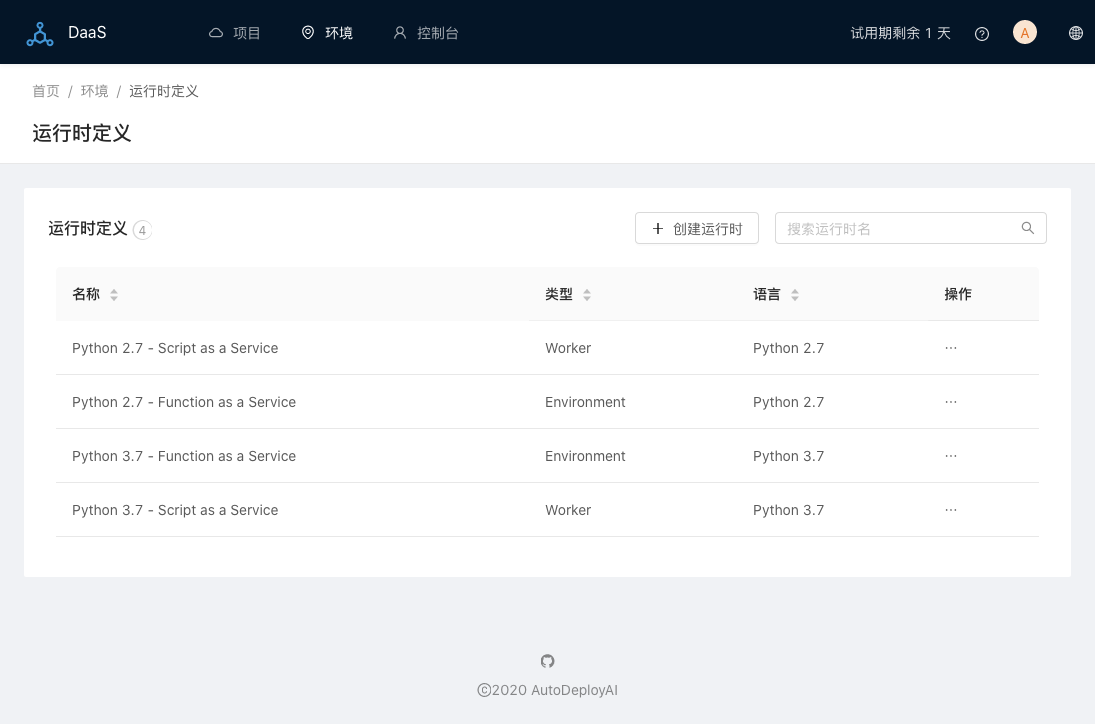
点击按钮创建运行时,创建基于pytorch:1.0镜像的Environment运行时:
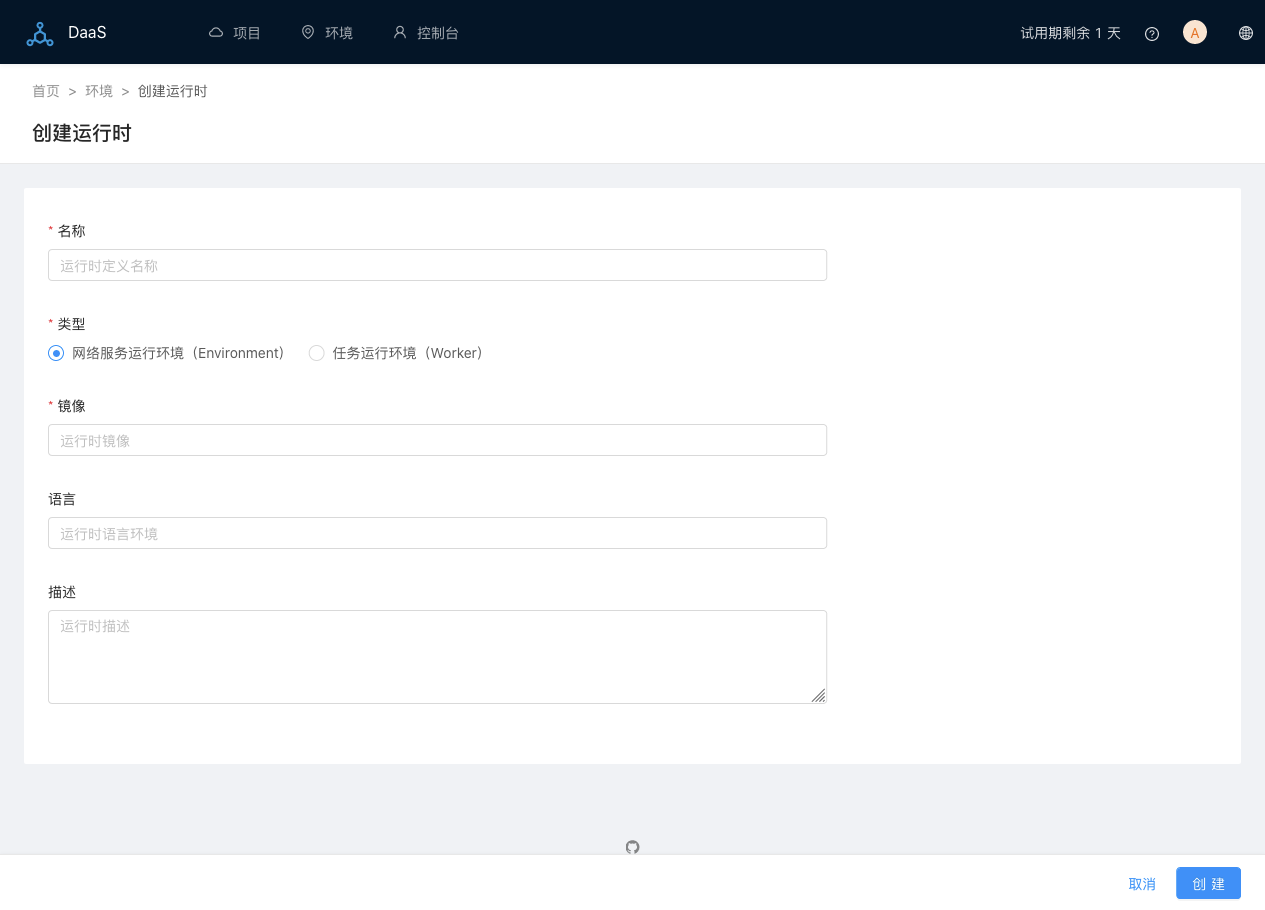
使用torchvision中的MNIST数据来识别用户输入的数字,以下代码参考官方实例:Image classification (MNIST) using Convnets。
首先,定义一个无参函数返回用户定义模型类(继承自torch.nn.Module)的一个实例,函数中包含所有的依赖,可以独立运行,也就是说包含引入的第三方库,定义的类、函数或者变量等等。这是能自动部署Pytorch模型的关键。
# Define a function to create an instance of the Net class
def create_net():
import torch
import torch.nn as nn # PyTorch's module wrapper
import torch.nn.functional as F
class Net(nn.Module):
def __init__(self):
super(Net, self).__init__()
self.conv1 = nn.Conv2d(1, 32, 3, 1)
self.conv2 = nn.Conv2d(32, 64, 3, 1)
self.dropout1 = nn.Dropout2d(0.25)
self.dropout2 = nn.Dropout2d(0.5)
self.fc1 = nn.Linear(9216, 128)
self.fc2 = nn.Linear(128, 10)
def forward(self, x):
x = self.conv1(x)
x = F.relu(x)
x = self.conv2(x)
x = F.relu(x)
x = F.max_pool2d(x, 2)
x = self.dropout1(x)
x = torch.flatten(x, 1)
x = self.fc1(x)
x = F.relu(x)
x = self.dropout2(x)
x = self.fc2(x)
output = F.log_softmax(x, dim=1)
return output
return Net()为了快速训练出模型,修改epochs=3
import torch
import torch.nn.functional as F
import torch.optim as optim
from torchvision import datasets, transforms
from torch.optim.lr_scheduler import StepLR
def train(model, device, train_loader, optimizer, epoch, log_interval):
model.train()
for batch_idx, (data, target) in enumerate(train_loader):
data, target = data.to(device), target.to(device)
optimizer.zero_grad()
output = model(data)
loss = F.nll_loss(output, target)
loss.backward()
optimizer.step()
if batch_idx % log_interval == 0:
print('Train Epoch: {} [{}/{} ({:.0f}%)]\tLoss: {:.6f}'.format(
epoch, batch_idx * len(data), len(train_loader.dataset),
100. * batch_idx / len(train_loader), loss.item()))
def test(model, device, test_loader):
model.eval()
test_loss = 0
correct = 0
with torch.no_grad():
for data, target in test_loader:
data, target = data.to(device), target.to(device)
output = model(data)
test_loss += F.nll_loss(output, target, reduction='sum').item() # sum up batch loss
pred = output.argmax(dim=1, keepdim=True) # get the index of the max log-probability
correct += pred.eq(target.view_as(pred)).sum().item()
test_loss /= len(test_loader.dataset)
print('\nTest set: Average loss: {:.4f}, Accuracy: {}/{} ({:.0f}%)\n'.format(
test_loss, correct, len(test_loader.dataset),
100. * correct / len(test_loader.dataset)))
use_cuda = torch.cuda.is_available()
batch_size = 64
test_batch_size = 1000
seed = 1234567
lr = 1.0
gamma = 0.7
log_interval = 10
epochs = 3
torch.manual_seed(seed)
device = torch.device("cuda" if use_cuda else "cpu")
kwargs = {
'batch_size': batch_size}
if use_cuda:
kwargs.update({
'num_workers': 1,
'pin_memory': True,
'shuffle': True},
)
transform = transforms.Compose([
transforms.ToTensor(),
transforms.Normalize((0.1307,), (0.3081,))
])
dataset1 = datasets.MNIST('./data', train=True, download=True, transform=transform)
dataset2 = datasets.MNIST('./data', train=False, transform=transform)
train_loader = torch.utils.data.DataLoader(dataset1, **kwargs)
test_loader = torch.utils.data.DataLoader(dataset2, **kwargs)
model = create_net().to(device)
optimizer = optim.Adadelta(model.parameters(), lr=lr)
scheduler = StepLR(optimizer, step_size=1, gamma=gamma)
for epoch in range(1, epochs + 1):
train(model, device, train_loader, optimizer, epoch, log_interval)
test(model, device, test_loader)
scheduler.step()模型训练成功后,通过客户端publish函数,发布模型到DaaS服务器端。通过设置测试数据集x_test和y_test,DaaS会自动侦测模型输入数据格式(类型和维数),挖掘模式(分类或者回归),评估模型,并且自动存储x_test中的第一行数据作为样例数据,以方便模型测试使用。参数source_object指定为上面定义的create_net函数,该函数代码会被自动存储到DaaS系统中。
batch_idx, (x_test, y_test) = next(enumerate(test_loader))
# Publish the built model into DaaS
publish_resp = client.publish(model,
name='pytorch-mnist',
x_test=x_test,
y_test=y_test,
source_object=create_net,
description='A Pytorch MNIST classification model')
pprint(publish_resp)结果如下:
{
'model_name': 'pytorch-mnist', 'model_version': '1'}调用test函数,指定runtime为之前创建的pytorch:
test_resp = client.test(publish_resp['model_name'],
model_version=publish_resp['model_version'],
runtime='pytorch')
pprint(test_resp)返回值test_resp是一个字典类型的结果,记录了测试API信息,如下:
The runtime "pytorch" is starting
Waiting for it becomes available...
{'access_token': 'eyJ0eXAiOiJKV1QiLCJhbGciOiJSUzI1NiJ9.eyJ1aWQiOjEwMDAsInVzZXJuYW1lIjoiYWRtaW4iLCJyb2xlIjoiYWRtaW4iLCJleHAiOjE1OTYwNzkyNzksImlhdCI6MTU5NjAzMjQ3OX0.kLO5R-yiTY6xOo14sAxZGwetQqiq5hDfPs5WZ7epSkDWKeDvyLkVP4VzWQxxlPyUX6SgGeCx0pq-of6SYVLPcOmR54a6W7b4ZfKgllKrssdMqaStclv0S2OFHeVXDIoy4cyoB99MjNaXOc6FCbNB4rae0ufu-eZLLYGlHbvV_c3mJtIIBvMZvonU1WCz6KDU2fEyDOt4hXsqzW4k7IvhyDP2geHWrkk0Jqcob8qag4qCYrNHLWRs8RJXBVXJ1Y9Z5PdhP6CGwt5Qtyf017s7L_BQW3_V9Wq-_qv3_TwcWEyCBTQ45RcCLoqzA-dlCbYgd8seurnI3HlYJZPOcrVY5w',
'endpoint_url': 'https://192.168.64.7/api/v1/test/deployment-test/pytorch/test',
'payload': {'args': {'X': [{'tensor_input': [[[[...], [...], ...]]]}],
'model_name': 'pytorch-mnist',
'model_version': '1'}}}tensor_input是一个维数为(1, 1, 28, 28)的嵌套数组,以上未列出完整的数据值。
使用requests库调用测试API:
response = requests.post(test_resp['endpoint_url'],
headers={'Authorization': 'Bearer {token}'.format(token=test_resp['access_token'])},
json=test_resp['payload'],
verify=False)
pprint(response.json())返回结果:
{'result': [{'tensor_output': [[-21.444242477416992,
-20.39040756225586,
-17.134702682495117,
-16.960391998291016,
-20.394105911254883,
-22.380189895629883,
-29.211040496826172,
-1.311301275563892e-06,
-20.16324234008789,
-13.592040061950684]]}],
'stderr': [],
'stdout': []}测试结果除了预测值,还包括标准输出和标准错误输出的日志信息,方便用户的查看和调试。
把预测结果与本地模型结果进行比较:
import numpy as np
desired = model(x_test[[0]]).detach().numpy()
actual = response.json()['result'][0]['tensor_output']
np.testing.assert_almost_equal(actual, desired)测试成功后,可以进行正式的模型部署。与测试API test 类似,同样需要指定runtime为之前创建的pytorch。为了提升部署的性能和稳定性,可以为运行环境指定CPU核数、内存大小以及部署副本数,这些都可以通过 deploy 函数参数设定。
deploy_resp = client.deploy(model_name=publish_resp['model_name'],
deployment_name=publish_resp['model_name'] + '-svc',
model_version=publish_resp['model_version'],
runtime='pytorch')
pprint(deploy_resp)返回结果:
The deployment "pytorch-mnist-svc" created successfully
Waiting for it becomes available...
{'access_token': 'eyJ0eXAiOiJKV1QiLCJhbGciOiJSUzI1NiJ9.eyJ1aWQiOjEwMDAsInVzZXJuYW1lIjoiYWRtaW4iLCJyb2xlIjoiYWRtaW4iLCJwcm9qZWN0TmFtZSI6Ilx1OTBlOFx1N2Y3Mlx1NmQ0Ylx1OGJkNSIsInByb2plY3RMYWJlbCI6ImRlcGxveW1lbnQtdGVzdCIsImlhdCI6MTU5NjAyODU2N30.iBGyYxCjD5mB_o2IbMkSKRlx9YVvfE3Ih-6LOE-cmp9VoDde-t3JLcDdS3Fg7vyVSIbre6XmYDQ_6IDjzy8XEOzxuxxdhwFPnW8Si1P-fbln5HkPhbDukImShM5ZAcfmD6fNWbz2S0JIgs8rM15d1WKGTC3n9yaXiVumWV1lTKImhl1tBF4ay_6YdCqKmLsrLX6UqbcZA5ZTqHaAG76xgK9vSo1aOOstKLTcloEkswpuMtkYo6ByouLznqQ_yklAYTthdrKX623OJdO3__DOkULq8E-am_c6R7FtyRvYwr4O5BKeHjKCxY6pHmc6PI4Yyyd_TJUTbNPX9fPxhZ4CRg',
'endpoint_url': 'https://192.168.64.7/api/v1/svc/deployment-test/pytorch-mnist-svc/predict',
'payload': {'args': {'X': [{'tensor_input': [[[[...],[...],...]]]}]}}}使用requests库调用正式API:
response = requests.post(deploy_resp['endpoint_url'],
headers={'Authorization': 'Bearer {token}'.format(token=deploy_resp['access_token'])},
json=deploy_resp['payload'],
verify=False)
pprint(response.json())结果如下:
{'result': [{'tensor_output': [[-21.444242477416992,
-20.39040756225586,
-17.134702682495117,
-16.960391998291016,
-20.394105911254883,
-22.380189895629883,
-29.211040496826172,
-1.311301275563892e-06,
-20.16324234008789,
-13.592040061950684]]}]}正式部署结果和测试结果是相同的,除了通过DaaS-Client客户端程序,模型测试和模型部署,也可以在DaaS Web客户端完成,这里就不再赘述。
在上面的默认模型部署中,我们看到模型的输入数据是维数为(, 1, 28, 28)的张量(Tensor),输出结果是(, 10)的张量,客户端调用部署REST API时,必须进行数据预处理和结果后处理,包括读取图像文件,转换成需要的张量格式,并且调用和模型训练相同的数据变换,比如上面的归一化操作(Normalize),最后通过张量结果计算出最终识别出的数字。
为了减轻客户端的负担,我们希望这些操作都能在部署服务器端完成,客户端直接输入图像,服务器端直接返回最终的识别数字。在DaaS中,可以通过模型自定义部署功能来满足以上需求,它允许用户自由添加任意的数据预处理和后处理操作,下面我们详细介绍如何自定义部署上面的Pytorch模型。
登陆DaaS Web客户端,查看pytorch-mnist模型信息:
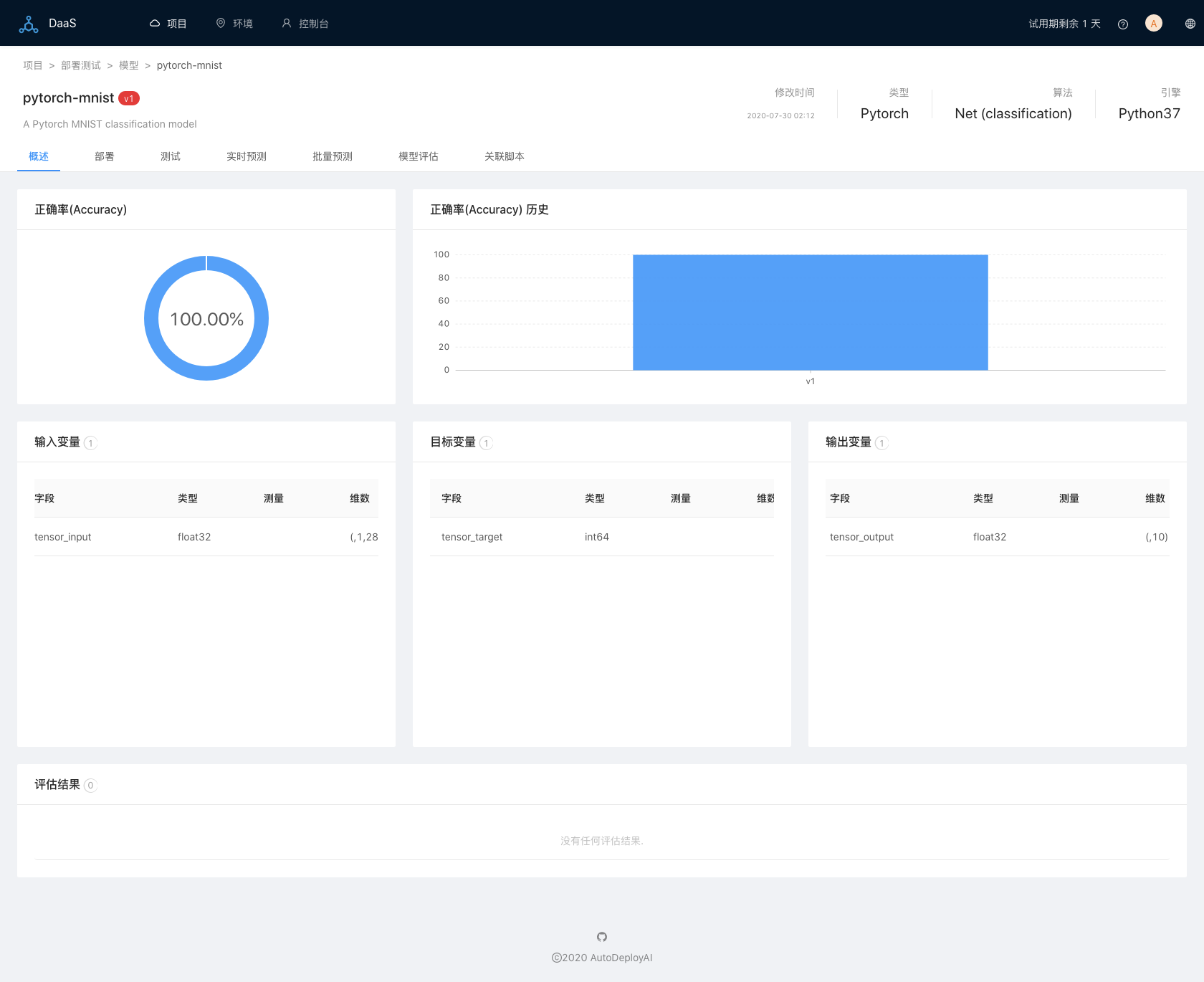
切换到实时预测标签页,点击命令生成自定义实时预测脚本,生成预定义脚本:
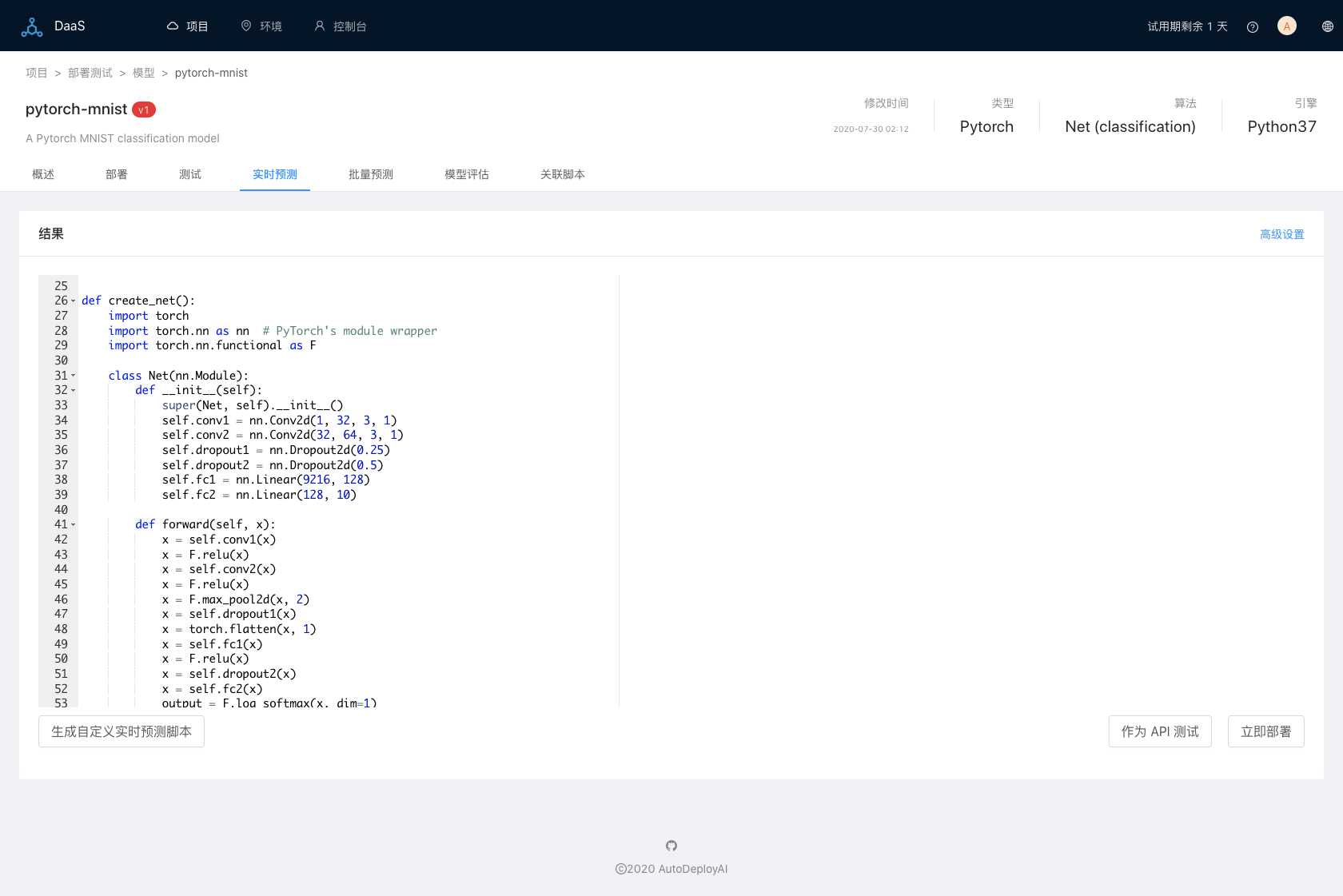
我们看到函数create_net内容会被自动写入到生成的预测脚本中,点击命令高级设置,选择网络服务运行环境为pytorch:
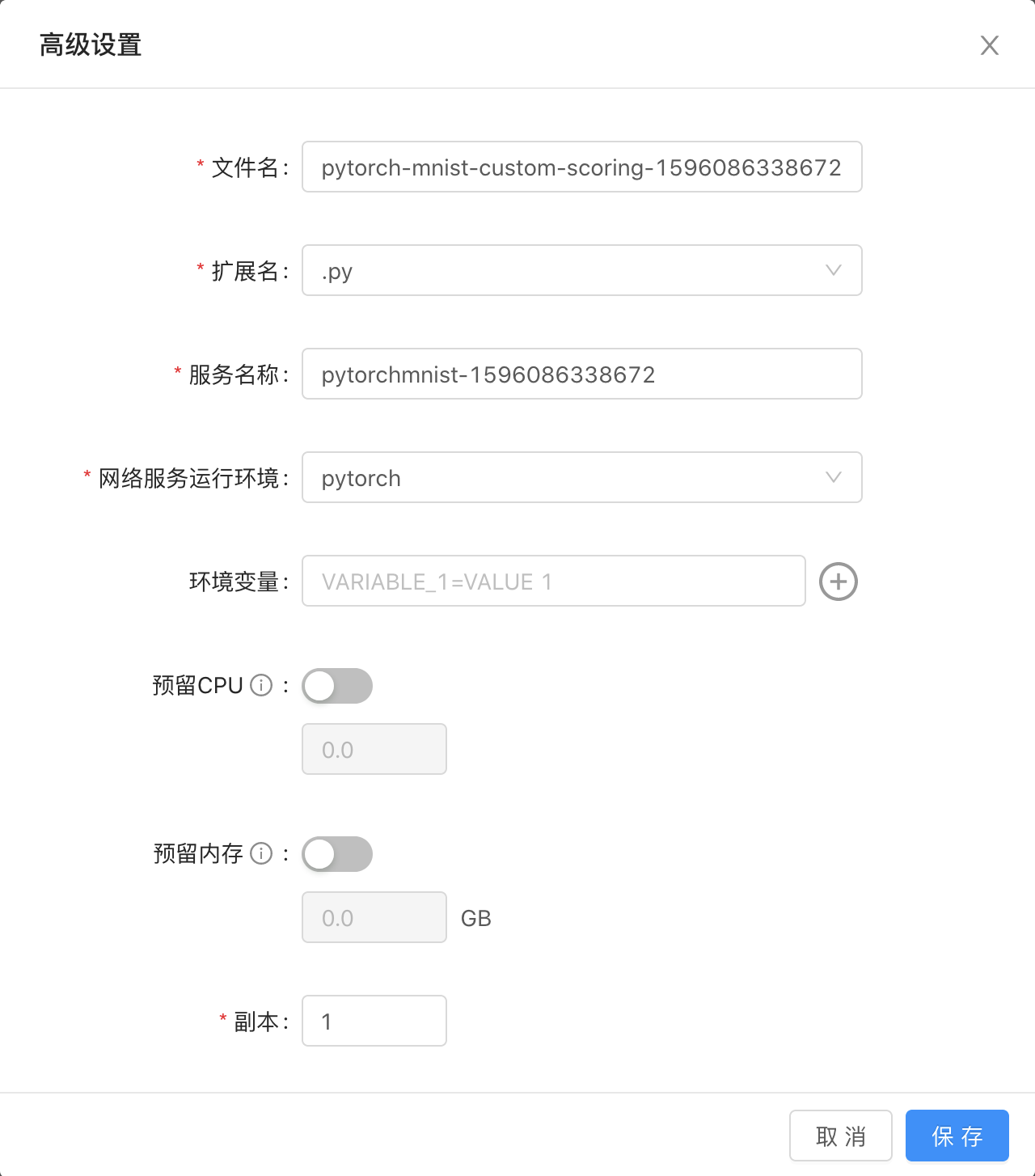
点击作为API测试命令,页面切换到测试页面,修改preprocess_files函数,引入模型训练时的图像处理操作:
def preprocess_files(args):
"""preprocess the uploaded files"""
files = args.get('files')
if files is not None:
# get the first record object in X if it's present
if 'X' in args:
record = args['X'][0]
else:
record = {}
args['X'] = [record]
from torchvision import transforms
transform = transforms.Compose([
transforms.ToTensor(),
transforms.Normalize((0.1307,), (0.3081,))
])
import numpy as np
from PIL import Image
for key, file in files.items():
img = Image.open(file)
normed = transform(img)
record[key] = normed.numpy()
return args完成后,输入函数名predict,选择请求正文基于表单,输入名称tensor_input,选择文件,点击上传测试图像test.png(该图像为上面测试使用的数据),点击提交,右侧响应页面将会显示预测结果:
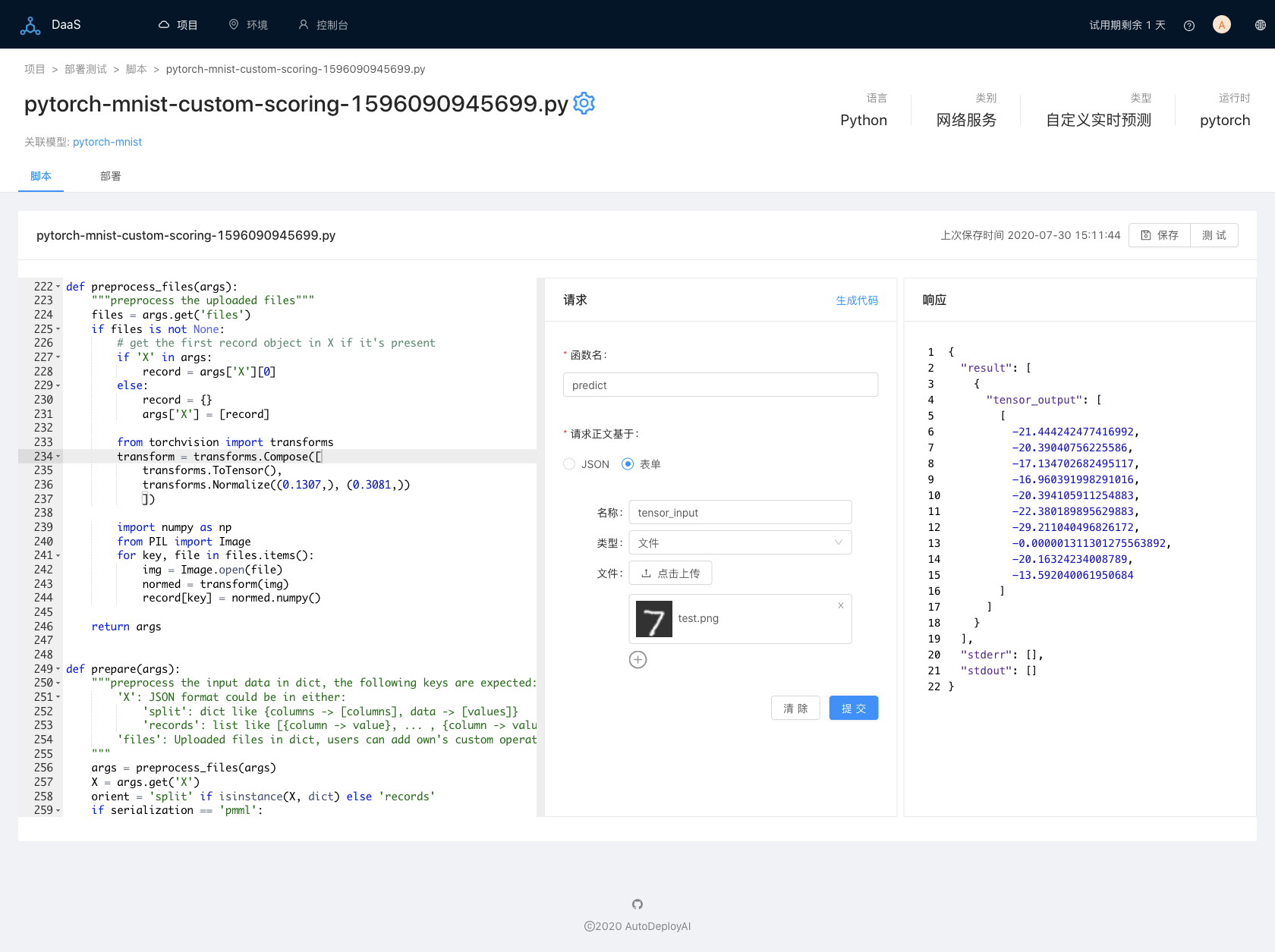
可以看到,结果与默认部署输出相同。继续修改postprocess函数为:
def postprocess(result):
"""postprocess the predicted results"""
import numpy as np
return [int(np.argmax(np.array(result).squeeze(), axis=0))]重新提交,右侧响应页面显示结果为:
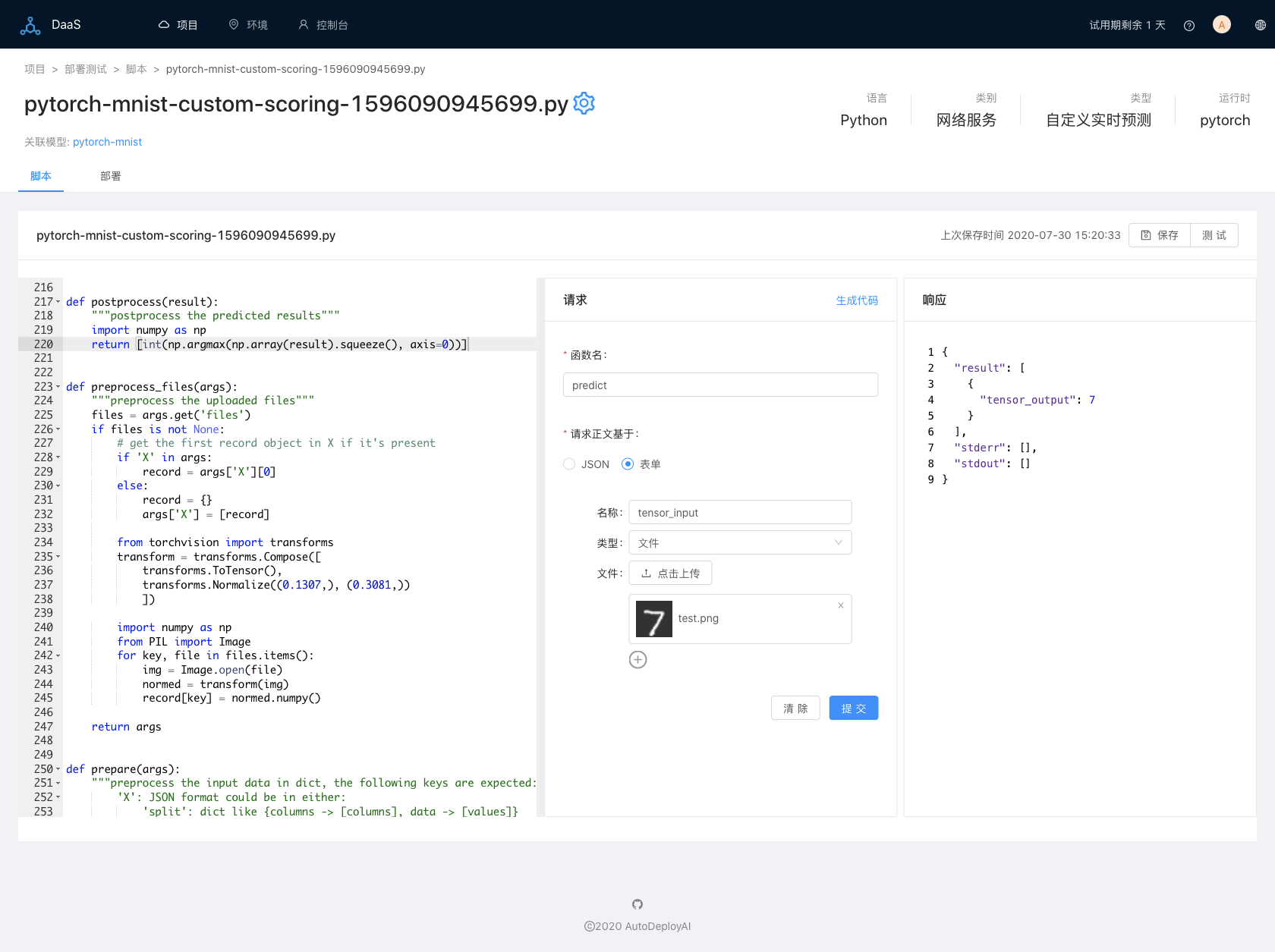
测试完成后,可以创建正式的部署,切换到部署标签页,点击命令添加网络服务,输入服务名称pytorch-mnist-custom-svc,网络服务运行环境选择pytorch,其他使用默认选项,点击创建。进入到部署页面后,点击测试标签页,该界面类似之前的脚本测试界面,输入函数名predict,请求正文选择基于表单,输入名称tensor_input,类型选择文件,点击上传测试的图片后,点击提交:
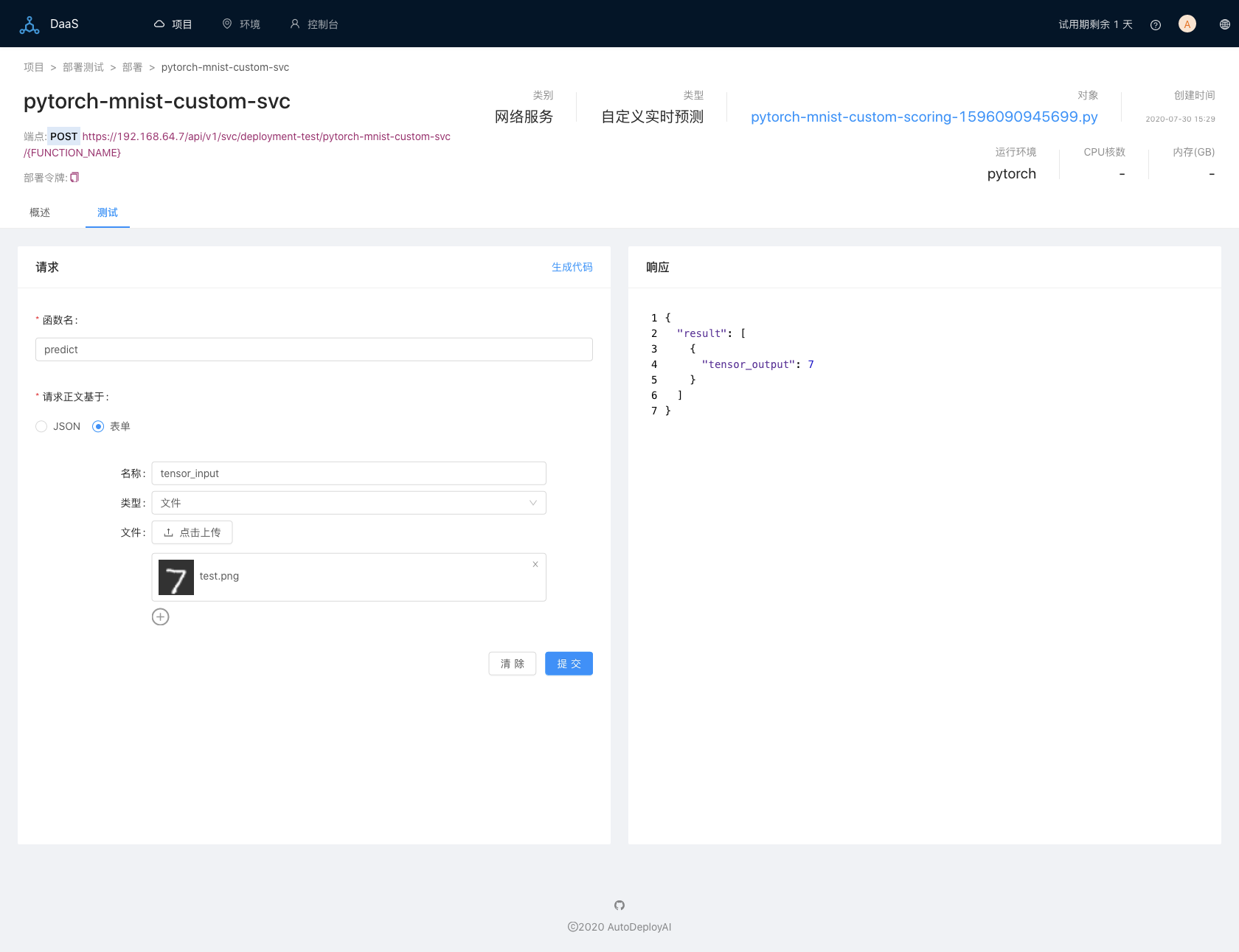
到此,正式部署已经测试和创建完成,用户可以使用任意的客户端程序调用该部署服务。点击以上界面中的生成代码命令,显示如何通过curl命令调用该服务,测试如下:

除了通过以上的原生部署,Pytorch库本身支持导出ONNX格式,所以通过ONNX来部署Pytorch模型是另一个选择,ONNX部署的优势是模型部署不再需要依赖Pytorch库,也就是不需要创建上面的pytorch运行时。可以使用DaaS默认自带的运行时Python 3.7 - Function as a Service,它包含了ONNX Runtime CPU版本用于支持ONNX模型预测。
# Export the model
torch.onnx.export(model, # model being run
x_test[[0]], # model input (or a tuple for multiple inputs)
'mnist.onnx', # where to save the model (can be a file or file-like object)
export_params=True, # store the trained parameter weights inside the model file
opset_version=10, # the ONNX version to export the model to
do_constant_folding=True, # whether to execute constant folding for optimization
input_names = ['tensor_input'], # the model's input names
output_names = ['tensor_output'], # the model's output names
dynamic_axes={
'input' : {
0 : 'batch_size'}, # variable lenght axes
'output' : {
0 : 'batch_size'}}
)publish_resp = client.publish('mnist.onnx',
name='pytorch-mnist-onnx',
x_test=x_test,
y_test=y_test,
description='A Pytorch MNIST classification model in ONNX')
pprint(publish_resp)结果如下:
{
'model_name': 'pytorch-mnist-onnx', 'model_version': '1'}上面,我们通过客户端的test函数来进行模型测试,这里我们使用另一个方式,在DaaS Web页面中测试模型。登陆DaaS Web客户端,进入pytorch-mnist-onnx模型页面,切换到测试标签页,我们看到DaaS自动存储了一条测试数据,点击提交命令,测试该条数据,如图:
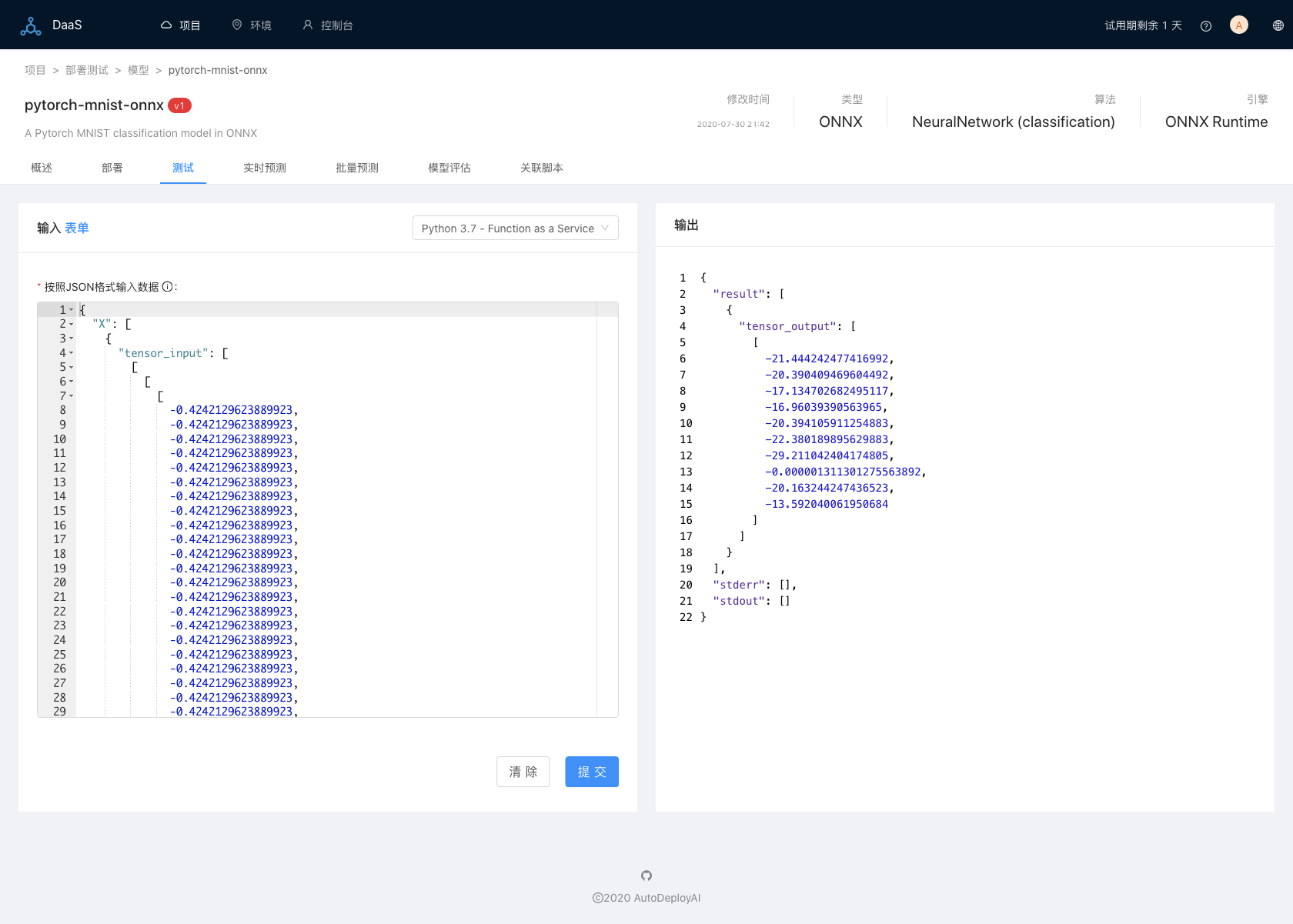
我们看到,该ONNX模型和原生Pytorch模型测试结果是一致的。
关于在DaaS Web界面中如何为ONNX模型创建默认部署和自定义部署,请参考文章《使用ONNX部署深度学习和传统机器学习模型》,流程相同,就不再这里赘述。
本文中,我们介绍了在DaaS中如何原生部署Pytorch模型,整个流程非常简单,对于默认部署,只是简单调用几个API就可以完成模型的部署,而对于自定义部署,DaaS提供了方便的测试界面,可以随时程序修改脚本进行测试,调试成功后再创建正式部署。在现实的部署中,为了获取更高的预测性能,用户需要更多的修改自定义预测脚本,比如更优的数据处理,使用GPU等。DaaS提供了简单易用的部署框架允许用户自由的定制和扩展。
如果您想体验DaaS模型自动部署系统,或者通过我们的云端SaaS服务,或者本地部署,请发送邮件到 autodeploy.ai#outlook.com(# 替换为 @),并说明一下您的模型部署需求。
上述就是小编为大家分享的如何上线部署Pytorch深度学习模型到生产环境中了,如果刚好有类似的疑惑,不妨参照上述分析进行理解。如果想知道更多相关知识,欢迎关注亿速云行业资讯频道。
亿速云「云服务器」,即开即用、新一代英特尔至强铂金CPU、三副本存储NVMe SSD云盘,价格低至29元/月。点击查看>>
免责声明:本站发布的内容(图片、视频和文字)以原创、转载和分享为主,文章观点不代表本网站立场,如果涉及侵权请联系站长邮箱:is@yisu.com进行举报,并提供相关证据,一经查实,将立刻删除涉嫌侵权内容。
原文链接:https://my.oschina.net/aipredict/blog/4672628